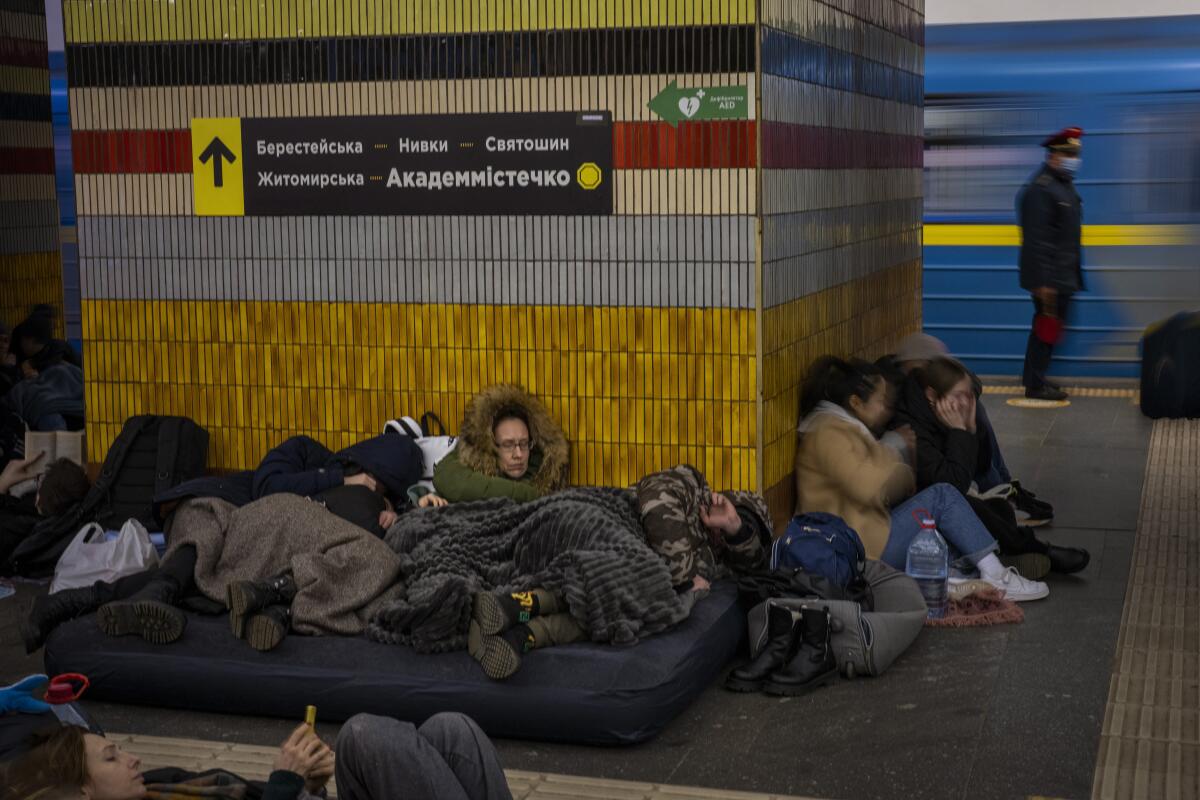A Word, Please: A few facts about the language of Ukraine, and some words we can use

- Share via
This column is about language, not foreign affairs.
But language is culture. It offers a way to form bonds with people from other lands. When a peaceful country is fighting for its survival, when civilians are being bombed in their homes and children are getting killed, learning a little about its language can be a small gesture of solidarity. And when those attacks are part of a worldwide assault on democracy itself, such an act of solidarity is simultaneously an act of American patriotism — a nod to the ideals of freedom and self-determination at home and abroad.
With that in mind, here are a few facts about the language of Ukraine.
Ukrainian is the first language of about 68% of the country’s 44 million residents. About 30% of Ukrainians speak Russian as their first language, while just under 3% speak Crimean Tatar, Moldovan, Hungarian, Romanian or any of the other three dozen languages spoken in Ukrainian homes.
Ukrainian is also common in some communities outside Ukraine, notably in Kazakhstan, Moldova, Poland, Lithuania and Slovakia.
Like English, Ukrainian is an Indo-European language, which means it is structurally similar to our own tongue, as well as to German, Greek, Celtic, Italian, Hindi and about 440 others. Ukrainian falls under the East Slavic sub-branch of Indo-European languages, making it a close cousin of Polish, Serbian, Czech, Russian, Belorussian and Bulgarian.
Ukrainian uses a form of the Cyrillic alphabet, which is very similar to the alphabet used for Russian. Think of the small differences between the alphabets used in Spanish and Portuguese, or those of Arabic and Farsi, and you get the idea.
The Ukrainian language has come under repeated attack for centuries. In 1863, a secret order called “The Valuyev Circular” was issued by a minister of the Russian Empire to prohibit publications in the Ukrainian language. After the Russian revolution of 1917, the Ukrainian language was afforded equal status in the region. But forced “Russification” resumed in the 1930s and more attempts to suppress Ukrainian ensued.
Ukrainian became the official language of Ukraine in 1989 — about two years before the Ukrainian Soviet Socialist Republic claimed its independence — and was reaffirmed as the country’s only official language in 1996 in the country’s constitution.
Singular subjects get verbs conjugated in the singular, and plural subjects get verbs conjugated in the plural. But language can get complicated.
The easiest way to learn a language that uses a different alphabet is by using “transliterated” forms. Transliteration converts the sounds from one language into the alphabet of another, like the Q in al-Qaeda, which represents a sound that we don’t make in English. Transliterations aren’t standardized, which you may have noticed when reading about Libyan leader Muammar al-Qaddafi/Gaddafi/Kadafi. That’s why you’ll see different spellings of the last name of Ukrainian President Volodymyr Zelensky/Zelenskiy/Zelenskyy.
There’s no single correct way to transliterate it, and newsrooms have different processes for deciding which transliterated spelling will become their official style.
Ukrainians pronounce their capital city, Kyiv, using sounds that don’t quite exist in English. But it’s closer to “Keev” than to “Key-ev,” which is more of a Russian pronunciation.
If you search Google for “English to Ukrainian,” you’ll arrive at a translator app where you can type in an English word or passage and Google will, with varying degrees of accuracy, translate it, showing both the Ukrainian Cyrillic form and a transliterated form. Click the little speaker button underneath to hear your term spoken aloud in proper Ukrainian.
You can reverse the process, too: If you come across Ukrainian text online, you can copy and paste it into Google Translate to get an English translation, though it may not be a very good one.
Here, transliterated by Google, are a few Ukrainian terms worth learning.
Hello: zdravstvuyte. The Google pronunciation sounds like “stravs-TOO-ee-tay.”
Welcome: laskavo prosymo. The emphasis is on the second syllable of the first word, las-KA-vo, and the first syllable of the second word, PROSS-im-o.
Cheers: budmo. When Ukrainians toast, they use this term that literally means “let us be.”
Glory to Ukraine: Slava Ukrayini! is the official salute of the Ukrainian armed forces since 2018.
Peace: myr. It sounds almost like “muid,” and its written form is identical to the Russian word for peace.
June Casagrande is the author of “The Joy of Syntax: A Simple Guide to All the Grammar You Know You Should Know.” She can be reached at [email protected].
All the latest on Orange County from Orange County.
Get our free TimesOC newsletter.
You may occasionally receive promotional content from the Daily Pilot.




